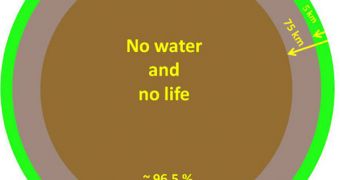Researchers have just completed an investigation that could have major implications for space exploration in the future. The team compiled a dataset regarding our planet's ability to support life. For many years, astronomers and astrobiologists have been peddling on the idea that liquid water on another planet or moon would be enough to set the stage for life to emerge. But the new study appears to paint a more complex picture. Scientists who carried it out say that only 0.2 percent of Earth is capable of supporting life, which is a very narrow margin, Space reports.
For example, water can penetrate within our planet's crust only to depths of about 75 kilometers. Below this threshold, excessive temperatures and pressures allow no further advancements. But this depth is not suitable for supporting living organisms, even if it does contain water. Therefore, the part of our planet that features water is about 3.3 percent of its overall volume. The remaining portion does not have any water, and cannot support life. The area that is inhabited by plants, animals and microorganisms represents a 5-kilometer stretch of the atmosphere, plus one kilometer underground, in the world's deepest caves and ocean bottoms.
This accounts for only about 0.2 percent of our planet. It is a very small percentage, and scientists say that this work could help inform astrobiologists' efforts of discovering signs of life on extraterrestrial worlds. The researchers behind the new study – which is detailed in the latest issue of the esteemed scientific journal Astrobiology – say that they took 121 degrees Celsius as the upper limit for what they termed “habitable water.” Beyond this limit, no organisms were found to endure in water. The lower limit was set at -20 degrees Celsius, although water has been found to exist at -89 degrees in thin films, and under very specific conditions.
The new investigation essentially “shows that life and water are not equivalent. There may be a lot of liquid water that is hostile to life,” explains Australian National University expert Eriita Jones, who was also the author of the paper. “Stated this way it sounds surprising and seems to suggest that the 'follow the water' strategy for life search needs rethinking,” explains NASA Ames Research Center scientist Chris McKay. At this point, astrobiologists use this catchphrase to inform all studies that search for life on other worlds.

 14 DAY TRIAL //
14 DAY TRIAL //